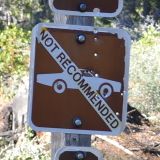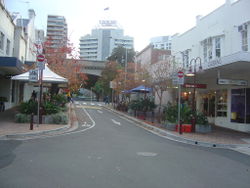Zh-hant:Key:access
 |
| 說明 |
|---|
| 用作描述法定通行權的元素 |
| 組: Restrictions |
| 用於這些元素 |
| 已記載的值: 24 |
| 常用組合 |
| 狀態:習慣使用 |
| 此標籤的工具 |
Access的值常用作描述公路或其他交通運輸網絡(鐵道、水道)的法定通行權利,也常見於建築物入口、建築物、設施或遊憩設施。
值可以使用access的值或關於特定運輸形式的標籤,例如為具有highway=service的服務道路標記access=delivery,表示該入口只用於運輸使用。
建築物入口只允許步行顧客進出應標記 entrance=yes與foot=customers。另外,交通方式的限制可能是高度、寬度、時間、日期或通行方向等。
Access標籤的值
| 值 | 說明 |
|---|---|
yes
|
一般大眾擁有正式的法定通行權。 |
no
|
一般大眾禁止進入。考慮使用其他的通行權標籤(例如foot=yes、bicycle=permissive)以指定誰能使用此元素。如果只有特定運輸模式被禁止,例如禁止機動車輛進入標誌,可以使用 vehicle=no、motor_vehicle=no。
|
private
|
只限私人允許通行。 |
permissive
|
開放供大眾通行,直到未來所有權人禁止大眾通行。 |
destination
|
只限通行至此元素或區域(限當地車輛)。
注解:此限制常只適用特定運輸模式(例如只限機動車輛)。注意使用正確的運輸模式,例如當只有機動車輛受到限值時,使用 英語:「 except for access」(英國)/「no thru traffic」/「local traffic only」(美國)。 |
delivery
|
只限運輸至該元素者通行。 |
customers
|
只限該元素的顧客通行。如果不開放任何願意付費使用者,考慮使用private替代。私人俱樂部一般標記為private。
|
designated
|
為特定類別的交通方式設計或適用的路線,例如foot=designated,一般代表有明確的標誌或標線指示(如允許行人通行)。
勿將此值使用於一般的 關於強制自行車行駛獨立自行車道,參見 |
use_sidepath
|
只限強制自行車行駛獨立自行車道的國家使用,並提供平行道路的資訊。參見bicycle=use_sidepath。
|
dismount
|
允許特定車輛(或動物)下車或下馬牽行。大部分用於自行車:當自行車禁止騎乘的路段使用bicycle=dismount(例如穿越墓地),但允許下車牽行自行車。參見自行車#自行車限制。
|
agricultural
|
只限農業用途使用。注意:農家的進出聯絡道路應為私人(private),而非農業用途(agricultural ),除非農路開放任何供農用的車輛通行。 |
forestry
|
只允許林業用途通行。 |
discouraged
|
有合法通行權(參見yes),但官方不鼓勵使用(例如狹窄可通行的HGV車道)。只有使用交通標誌公告時才能使用(否則流於主觀判斷)。
 |
unknown
|
The access conditions are unknown or unclear. For the access key, where users might assume access rights by definition or some default, this makes it explicit that the actual situation is not known (since an absent access tag might also be mistaken by some users as being compliant to an assumed default). These tags should therefore not be removed without replacing them with a better alternative |
法定通行時間與其他條件限制
Restrictions may be limited to a particular time or day. Or they may limit the access for vehicles over a certain weight. Such conditions can be tagged as shown in these tagging examples:
- Only destination access is permitted during 8am and 5pm on Mondays to Fridays:
access:conditional=destination @ (Mo-Fr 08:00-17:00) - Motor vehicles heavier than 5 tonnes may only access this street for the purpose of delivering goods:
motor_vehicle:conditional=delivery @ (weight>5)
Please note that the above tagging style can be used to replace the following time dependent restrictions. It has been suggested that they be deprecated and should therefore no longer be used. date_on=*, date_off=*, day_on=*, day_off=*, hour_on=*, hour_off=*. Also note, that using of conditional tag assumes overt indication of value, which mostly suites as a default value. For example, if access is open on one part of day (on this part of day access=permissive) and is closed on other part of day (on this part of day access=private), we have a situation, when we should mark the object with a tag access=permissive or access=private. There is no concrete, precise and universal algorithm to define, if we should use permissive or private in concrete situation, but we can definitely say, that in such case we can't use access=yes (or not use tag access at all), because access=yes (or absence of tag access) means round-the-clock open access for general public.
- For a full description and more examples, please see the conditional restrictions page.
尺寸與法定限制
許多法定限制基於高度、寬度、重量等。如果單位是公制時,值不需加入單位:長度以公尺為單位,重量以公噸為單位,時間以小時為單位。十進位數量應包含小數點。
Exceptions include speeds which should be in mph in places where speed limits are defined in these units and times which can include a suffix of 'days' if appropriate.
maxweight=*maxaxleload=*maxheight=*height restriction.maxheight:physical=*physical height restriction.maxwidth=*(also notewidth=*for the physical width of the entire road.)maxlength=*maxdraught=*maxspeed=*(km/h by default, mph where specified)minspeed=*mindistance=*minimum trailing distance, often asmindistance:hgv=*on old bridges or in tunnelsmaxstay=*(maximum parking time)
路線限制
單行限制
Ways may have different access restrictions for each direction. The most simple case is a way designated as a oneway road:
oneway=yes- Driving is only allowed in the direction of the way.
oneway=-1- Driving is only allowed against the direction of the way.
oneway=no- Default. Access is allowed in both directions (this key/value combination does not normally need to be added to ways, unless another tag such as
highway=motorwayimplies oneway=yes).
For more complex direction dependent restrictions, the postfixes :backward and :forward can be used on the keys, for example:
bicycle:backward=no- When a road has a oneway cycleway next to it that must be used, and a cyclelane in the other direction.
bicycle:backward=yes- When cyclists are allowed to travel in both directions on a oneway street (but no lane is present).
Also in use when cyclists are allowed to travel in the opposite direction:
cycleway=oppositecycleway=opposite_lane- Only if a separate lane exists.
cycleway=opposite_track- Only if a separate track exists.
oneway:bicycle=no- Consistent with tags based on conditions. Note: This was previously tagged as "bicycle:oneway=no", but this is deprecated.
The oneway tag can be translated (for routing purposes) to this generic system as follows (oneway restrictions presumably do not apply to pedestrians):
單一車道限制
- 主條目:Lanes
通行限制因車道而異。
hgv:lanes=no|yes|yes- 三車道時,重型貨車禁止通行左側車道。
bus:lanes:forward=no|yes|designated- 三車道時,前方路段公車禁止通行左側車道。右側車道是公車專用道。
運輸模式限制
Use the access=* key to describe a general access restriction that applies to all transport modes.
In theory, adding access=yes to highway=footway could be read as changing default restrictions (which usually are foot=yes and vehicle=no for highway=footway) to yes, highway=footway + access=yes means "road, which is open for all pedestrians and vehicles".
In practice, this combination is often used by mappers to modify (rather than enlarge) default values: for example, access=permissive with highway=steps is very unlikely to be traversable by a truck, whatever the tags may say.
To avoid ambiguity, you may therefore want to avoid general tags access=yes and access=permissive, and use more specific transport modes where appropriate. For example, to distinguish a footway with open access from one with private access, use tags like foot=yes and foot=private instead of access=yes and access=private.
Where different restrictions apply to different modes of transport then mode specific tags can be used. These modal tags each have a place in a hierarchy in which keys become narrower in scope as they branch out from the root.
For example:
access=no,bus=yesmeans that only buses are allowed to enter (for example a road only for buses)access=yes,motor_vehicle=nomeans that all transport modes except motor vehicles can use the elementaccess=forestry,foot=permissiveimplies that forestry vehicles can use the route legally and that pedestrians can use it by currently but that permission may later be withdrawn.- See examples section for more examples.
陸路運輸
This hierarchy is different in each country. So it's possible that your country has vehicle classes which aren't in this list, doesn't have some which are, and some vehicle classes may even have a different definition from the one listed below:
access=*(category: any land-based transportation mode)- Moving without a vehicle

foot=*(pedestrians)ski=*ski:nordic=*(![[W]](https://upload.wikimedia.org/wikipedia/commons/thumb/0/00/Tango_style_Wikipedia_Icon_no_shadow.svg/16px-Tango_style_Wikipedia_Icon_no_shadow.svg.png) cross-country skiing)
cross-country skiing)ski:alpine=*(downhill skiing)ski:telemark=*(![[W]](https://upload.wikimedia.org/wikipedia/commons/thumb/0/00/Tango_style_Wikipedia_Icon_no_shadow.svg/16px-Tango_style_Wikipedia_Icon_no_shadow.svg.png) telemark skiing, free-heel)
telemark skiing, free-heel)
inline_skates=*ice_skates=*

horse=*(horse riders)vehicle=*(category: any vehicle)- Non-motorized vehicle
- Single-tracked

bicycle=*(cyclists)
- Double-tracked

carriage=*(horse(s) and carriage)
trailer=*(needs to be towed by another vehicle which has its own restrictions)
caravan=*(a![[W]](https://upload.wikimedia.org/wikipedia/commons/thumb/0/00/Tango_style_Wikipedia_Icon_no_shadow.svg/16px-Tango_style_Wikipedia_Icon_no_shadow.svg.png) travel trailer, also known as caravan)
travel trailer, also known as caravan)
- Single-tracked
motor_vehicle=*(category: any motorized vehicle)- Single-tracked

motorcycle=*(a 2-wheeled motor vehicle, allowed to drive on motorways)moped=*(motorized bicycles with a speed restriction; e.g., at most a 50 cc engine or max. speed of about 45 km/h)
mofa=*("low performance moped", usually with a maximum design speed of 25 km/h)
 Double-tracked (category: motor vehicles with more than 2 wheels/more than 1 track)
Double-tracked (category: motor vehicles with more than 2 wheels/more than 1 track)

motorcar=*automobiles/cars (in restrictions it can imply the generic class of double-tracked motorized vehicles)
motorhome=*(a![[W]](https://upload.wikimedia.org/wikipedia/commons/thumb/0/00/Tango_style_Wikipedia_Icon_no_shadow.svg/16px-Tango_style_Wikipedia_Icon_no_shadow.svg.png) motorhome)
motorhome)
tourist_bus=*describes a bus that is not acting as a public transport bus service, usually for long-distance travel but not always
coach=*a bus for long-distance travel, not part of a public transport bus servicegoods=*(light commercial vehicles; e.g., goods vehicles with a maximum allowed mass of up to 3.5 tonnes)
hgv=*(heavy goods vehicle; e.g., goods vehicles with a maximum allowed mass over 3.5 tonnes)
hgv_articulated=*articulated heavy goods vehicle

agricultural=*(agricultural motor vehicles; e.g., tractors) that have additional restrictions; e.g., a 25 km/h speed limit)atv=*a.k.a. Quad (bike) (Restricted to or permissive for vehicles 50 in, 1.27 m, or less in width) still in proposal stage. You may want to usemaxwidth=1.27instead.snowmobile=*
- By use
psv=*(public service vehicle)
bus=*(a heavy bus acting as a public service vehicle)minibus=*(a light bus acting as a public service vehicle)share_taxi=*(a light bus acting as demand responsive transit)taxi=*(taxi)
hov=*(high-occupancy vehicle/carpool, varies by location; e.g., at least one passenger)car_sharing=*(car sharing vehicles)emergency=*(category: emergency motor vehicles; e.g., ambulance, fire truck, police car)hazmat=*(motor vehicles carrying hazardous materials)disabled=*(holders of blue badge, UK, or other such disabled persons' permit. Used on traffic signs to exempt said group from access restrictions; not just regarding parking)
- Single-tracked
- Non-motorized vehicle
- Moving without a vehicle
其他
- Hybrid cars, electric vehicles, other no-emission vehicles (e.g., hydrogen powered).
- Car hire with driver.
4wd_only=*
![[W]](https://upload.wikimedia.org/wikipedia/commons/thumb/0/00/Tango_style_Wikipedia_Icon_no_shadow.svg/16px-Tango_style_Wikipedia_Icon_no_shadow.svg.png) road_train (should that be "hgv_caravan" ?).
road_train (should that be "hgv_caravan" ?).- Other configurations of hgvs -
![[W]](https://upload.wikimedia.org/wikipedia/commons/thumb/0/00/Tango_style_Wikipedia_Icon_no_shadow.svg/16px-Tango_style_Wikipedia_Icon_no_shadow.svg.png) B-double, double-B doubles and 2AB quads.
B-double, double-B doubles and 2AB quads. ![[W]](https://upload.wikimedia.org/wikipedia/commons/thumb/0/00/Tango_style_Wikipedia_Icon_no_shadow.svg/16px-Tango_style_Wikipedia_Icon_no_shadow.svg.png) Hand cart: a cart that is pulled or pushed by one or more people.
Hand cart: a cart that is pulled or pushed by one or more people.![[W]](https://upload.wikimedia.org/wikipedia/commons/thumb/0/00/Tango_style_Wikipedia_Icon_no_shadow.svg/16px-Tango_style_Wikipedia_Icon_no_shadow.svg.png) Auto rickshaw: a motorized version of the traditional pulled rickshaw or cycle rickshaw.
Auto rickshaw: a motorized version of the traditional pulled rickshaw or cycle rickshaw.
水路運輸
access=*(category: any water-based transportation mode)boat=*(covers small boats and pleasure crafts, including yachts)motorboat=*(boats and yachts using motor, on also for sailing boats using the motor)
also for sailing boats using the motor)sailboat=*(boats and yachts using sails, on doing way with sail, not using the motor (according to the definition of the Colreg))
doing way with sail, not using the motor (according to the definition of the Colreg))canoe=*(boats without sail or motor, such as small dinghies, canoes, kayaks, etc.)
fishing_vessel=*(covers fishing vessels of any size)ship=*(covers commercial vessels of any size and any trade)passenger=*(ships carrying passengers, either as a scheduled service (ferries, etc.) or as cruise)cargo=*(any type of cargo ship)bulk=*(covers all dry bulk cargo)tanker=*(covers all wet bulk cargo, including compressed gas)tanker:gas=*(compressed or liquefied gas)tanker:oil=*(crude oil and oil products)tanker:chemical=*(all other products in tanks)tanker:singlehull=*(special coverage for single hull as most of Europe and US have more restrictive rules for single hull tankers than for double hull. The general tag is for double hull if this tag is in use.)
container=*(collective tag for general cargo)imdg=*(dangerous cargo covered by the![[W]](https://upload.wikimedia.org/wikipedia/commons/thumb/0/00/Tango_style_Wikipedia_Icon_no_shadow.svg/16px-Tango_style_Wikipedia_Icon_no_shadow.svg.png) International Maritime Dangerous Goods Code, IMDG)
International Maritime Dangerous Goods Code, IMDG)
isps=*(International Ship and Port Facility Security Regulation.)
As suggested, see discussion.
鐵路運輸
設施限制
設施可標記的通行權,一般包含:
- building entrances, which can be used to model that different entrances are for different groups of users,
- buildings themselves,
- amenities, often used on
amenity=parkingwith restrictions to private (e.g. company employees only) or customers (people visiting a shop), - leisure entities, such as
leisure=sports_centreorleisure=playgroundwhere private describes a closed user group, e.g. members only or children of a particular school.
節點、路徑與區域
Tags of "access" group can be used for nodes, ways and areas. There are different priorities in OSM-community, where to put access tag: to area (usually it is a square, which have some specific conditions of access), to line (usually it is roads inside square) or to node (usually it is gate in barrier, which surrounds square, where there is a possibility to enter the area). Note that access tags mark legal status of territory and barriers and warning signs are only physical reflections of restrictions in area. In such manner, area with private status should have appropriate values, even there is no surrounding barrier or it is broken. Note, that different entrances can have different access values and different roads inside area can have different access values too. For example, we have area with permissive access - so we mark it with access=permissive. But there are several entrances, one of which is designated for all people, and other - only for persons, which have key. So we mark one entrance with access=permissive and other - with access=private. Another example - we have botanical garden with permissive access, which have roads, which are designated for public, and roads, which are designated only for staff of garden. In such case we have access=permissive at one roads and access=private (or access=no) at another.
When you are tagging some area, it is your decision, where to put "access" tags: to area, to entrances or to roads inside area (because nobody can bring you to add some tags somewhere), but removal of correct tags, which were put but someone else, is a mistake (and is close to vandalism). If you like to put tags to areas, do it, if you like to put tags to roads inside areas, do it, if you like to put tags to entrances, do it. But don't delete tags from type of elements, which you don't like.
範例
bicycle=yesThe public has a right of way when travelling on a bicycle.horse=designatedThe route is designated for use by equestrians.motorcycle=unknownIt is unclear whether motorcycles can use this section.motorcar=privateThe owner must give access to cars on an individual basis. Access by car is private; e.g., on a private road.goods=noGeneral goods vehicle traffic is not allowed.hgv=noHeavy goods vehicle traffic is not allowed.boat=noWaterway is not available for boat traffic.oneway=yes+psv=opposite_laneThe street is one way for cars but there is one opposite lane for buses and taxis.maxweight=7The weight limit is 7 tonnes.maxaxleload=3.5The restricted weight limit per axle in tonnes; e.g., 3.5 t.maxheight=2.5The maximum vehicle height is 2.5 meters.maxdraught=1The maximum boat draught is 1 meter.maxspeed=110The maximum speed limit is 110 km/h.maxspeed=55 mphThe maximum speed limit is 55 mph.maxstay=14 daysThe maximum stay permitted; units in the tag as either hour/hours or day/days.

A one-way street with a cycle lane in the opposite direction:
延伸閱讀
- Implicit default values
- Conditional restrictions
access=designated- different explicit administrative designations (like footway, cycleway, bridleway)highway=cyclewayhighway=footwayhighway=bridleway- Approved features/More access keys and values
male=*,female=*,unisex=*min_age=*,max_age=*